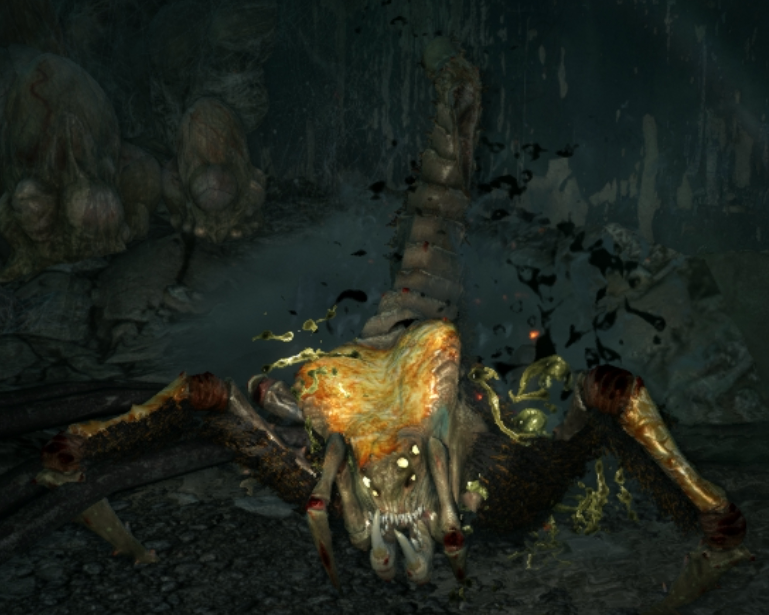Spiderbug

These mutant arachnids were first encountered deep within the bowels of the Moscow metro stations, sewers and utility tunnels only a few months after the end of the final wars. In the ensuing decades, the creatures spread like wild-fire and can now be found everywhere in Europe, Asia, the Middle East and Africa. Fortunately they have yet to be discovered in the Asian islands of Japan, Philippines other continents, but it is feared that they will eventually find a way to colonize the as yet untouched lands.
No. Enc: 1d3 males / 1d2 females
Alignment: Neutral
Movement: 120’ (40’)
AC: 4 / 1
HD: 3 / 5
Attacks: 1 stinger or 1 bite and 1d3 claws / 1 bite and 2d3 claws
Damage: 1d6 plus poison (Class 4) / 1d4 /1d3 per claw / Female 1d8 plus poison (Class 7) / 1d4 per claw
Save: L3 / L5
Morale: 6
Hoard Class: Incidental
These mutant arachnids were first encountered deep within the bowels of the Moscow metro stations, sewers and utility tunnels only a few months after the end of the final wars. In the ensuing decades, the creatures spread like wild-fire and can now be found everywhere in Europe, Asia, the Middle East and Africa. Fortunately they have yet to be discovered in the Asian islands of Japan, Philippines other continents, but it is feared that they will eventually find a way to colonize the as yet untouched lands.
These creatures are the mutant descendants of a common type of spider that was found in Russia. As with many of the muscovite mutants that appeared shortly after the war, it is speculated that these creatures were in fact genetically engineered to be a weapon of terror that escaped (or worse, had been intentionally released) as the final wars came to a close.
Although of the same species, both male and females are physically quite different. Male spiders appear to be a chimera of the Scorpion and spider, and possess a long flexible tail identical in nature to the scorpion. They use this tail in combat, only resorting to a bite or claw if they run out of venom or are incapable of harming the opponent with the tail.
The males are around two feet in diameter and weigh around ten pounds, while the females grow to be about three to four feet in diameter and weigh about twenty-five pounds. Both are a light brown in color but if exposed to any light source, it darkens and takes on a reddish hue.
They live in large webs, which although annoying and sticky, do not pose a threat to most creatures. Every web contains 2d12 egg sacks that contain the creatures young in various stages of development. The eggs can be destroyed without risk, and many find that the flesh of the unborn young is very tasty and can be quite nutritious (1 meal will suffice for three days’ worth of food).
It should be noted that the adults are also safe to consume, and those who have eaten the soft flesh under the chitin find that it tastes a great deal like shrimp, crab and lobster. Consuming the flesh of the adults does not convey the same benefit as eating the young.
The venom from the males can be harvested and stored in an airtight container. It must be kept out of direct light or it will deteriorate into slurry of useless bio-chemical slime in 1d4 rounds. If used on a weapon, the venom retains its strength (class 4) and is good for a single attack. It is not fully understood why, but the female venom cannot be harvested as there does not seem to be an actual source for it present in the body.
As noted, the females are significantly larger but do not possess the tail. Instead they use their bite and multiple claws in combat. Just because they do not possess a tail does not mean they are weaker. The bite is as toxic as the tail attack, and they are larger and tougher than the male counterparts.
The male’s stinger contains enough venom for 2d4+4 strikes and once the venom is used up, it will regain the venom at a rate of 1d2 per four hours. The female can bite indefinitely without fear of running out of venom.
During combat the creatures will close in at strike with the tail or the bite. They will continue to attack without hesitation until they are killed or exposed to any sort of light source. Any light will cause the creature’s physical pain and it will begin to burn them. Simple light sources like torches will cause 1 point of damage per round, while flashlights or more powerful sources will cause 1d3 points per round. Ultraviolet light will force the creature to save versus death every round or die instantly, and even if the saving throw succeeds, they will still suffer 1d6 points of damage. While exposed to any light, the flesh of the creature will burn and flake off in clumps of ash.
Also the top half of these creatures is heavily armored in a thick chitin, but the underside is relatively un-armored. If anyone can manage to get beneath the creature they will discover that the AC is two categories worse there (6/3).
Due to their allergic reaction to light, these creatures are only found underground and never venture to the surface, as even the light of the moon will cause them harm.
Mutations: Aberrant form (xenomorphism), allergic reaction (light), thermal vision, toxic weapon, ultraviolet vision
Source: Metro 2033



